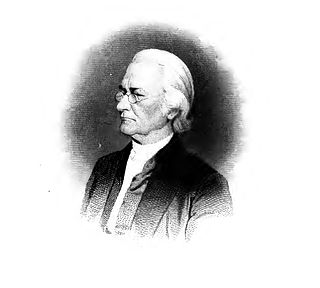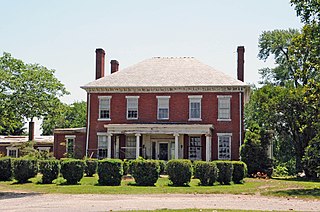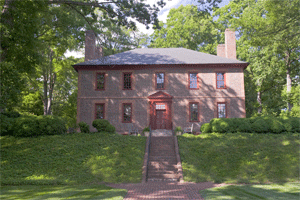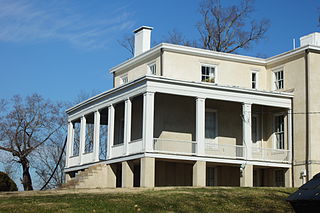
William Meade was an American Episcopal bishop, the third Bishop of Virginia.

Shadwell is a census-designated place (CDP) in Albemarle County, Virginia. It is located by the Rivanna River near Charlottesville. The site today is marked by a Virginia Historical Marker to mark the birthplace of President Thomas Jefferson. It is listed on the National Register of Historic Places along with Clifton.

Varina Farms, also known as Varina Plantation or Varina Farms Plantation or Varina on the James, is a plantation established in the 17th century on the James River about 10 miles (16 km) south of Richmond, Virginia. An 820-acre (330 ha) property was listed on the National Register of Historic Places in 1977 as "Varina Plantation". At that time it included two contributing buildings and one other contributing site.

Wilton House Museum is a museum in a historic house located in Richmond, Virginia. Wilton was constructed c. 1753 by William Randolph III, son of William Randolph II, of Turkey Island. Wilton was originally the manor house on a 2,000-acre (8.1 km2) tobacco plantation known as "World's End" located on the north bank of the James River several miles east of the city of Richmond. Between 1747 and 1759, William III acquired more than a dozen contiguous tracts of land. About 1753, Randolph completed building a Georgian manor house, which he named "Wilton," on a site overlooking the river.

White Post is an unincorporated community in Clarke County, Virginia. White Post is located at the crossroads of White Post Road and Berrys Ferry Road off Lord Fairfax Highway.

Tuckahoe, also known as Tuckahoe Plantation, or Historic Tuckahoe is located in Tuckahoe, Virginia on Route 650 near Manakin, Virginia overlapping both Goochland and Henrico counties, six miles from the town of the same name. Built in the first half of the 18th century, it is a well-preserved example of a colonial plantation house, and is particularly distinctive as a colonial prodigy house. Thomas Jefferson is also recorded as having spent some of his childhood here. It was declared a National Historic Landmark in 1969.

This is a list of the National Register of Historic Places listings in Henrico County, Virginia.

Hawthorne, also known as the Browder Place, is a historic Italianate plantation house and historic district in Prairieville, Alabama, USA. This area of Hale County was included in Marengo County before the creation of Hale in 1867. Hawthorne is included in the Plantation Houses of the Alabama Canebrake and Their Associated Outbuildings Multiple Property Submission. It was added to the National Register of Historic Places on July 7, 1994, due to its architectural significance.

Oakley is a historic plantation and home located in Spotsylvania County, Virginia, Virginia. The Federal/Georgian style, 2+1⁄2-story home was built in 1828 by Samuel Alsop, Jr. as a wedding present for his daughter, Clementina. Alsop built several notable houses in Spotsylvania County including Kenmore, Spotswood Inn, and Fairview.

Edge Hill, also known as Edgehill and Edgehill Farm, is a historic house located near Shadwell in Albemarle County, Virginia, United States.

Mulberry Hill is a historic plantation house located near Randolph, Charlotte County, Virginia. The original section dates to the 18th century and forms the slightly projecting, gable-end, two-story front center pavilion. Flanking this center section are single-bay two-story wings added in the mid-19th century. At the same time, a two-story rear wing was added. The front facade features a mid-19th century porch with a full Doric order entablature supported on octagonal Doric columns. Also on the property are the contributing Judge Paul Carrington's office building, a brick kitchen, a frame spinning house, a dairy, a smokehouse, a privy, and servants' quarters. It was the home plantation of 18th century political official and jurist Paul Carrington (1733–1818). He is buried on the plantation grounds.

Old Chapel is a historic Episcopal church building located near Millwood, Clarke County, Virginia. Old Chapel is now the oldest Episcopal church building still in use west of the Blue Ridge Mountains. It was listed on the National Register of Historic Places in 1973. In 2014, the Chapel Rural Historic District was recognized, and which encompasses both Cunningham parish churches, discussed below, as well as approximately 700 other structures and an area of nearly 10,500 acres.

Annefield or Annfield is a historic plantation house located near Boyce, Clarke County, Virginia. Matthew Page (1762–1826) built it beginning around 1790, and named it after his new wife, Ann Randolph Meade (1781–1838), daughter of Richard Kidder Meade and sister of William Meade, whom he married in 1799.

White Post Historic District is a national historic district located at White Post, Clarke County, Virginia. It encompasses 23 contributing buildings and 1 contributing object in the crossroads village of White Post. The contributing object is the white-painted marker which Thomas, Sixth Lord Fairfax, had erected in the 1760s to point the way to Greenway Court, his nearby estate.

Elk Hill, also known as Harrison's Elk Hill, is a historic plantation home located near Goochland, Goochland County, Virginia. It was built between 1835 and 1839, and is a 2+1⁄2-story, three-bay, stuccoed brick central-hall-plan house in the Greek Revival style. It has a two-story rear ell. The front facade features a one-story Tuscan order portico consisting of paired rectangular wooden pillars supporting a full entablature. Also on the property are the contributing servants' quarters, tack house, and spring house. It was listed on the National Register of Historic Places in 1979.

Norwood is a historic plantation house located near Powhatan, Powhatan County, Virginia. It was built in the 18th century and remodeled about 1835. It is a two-story, five bay, Federal style brick dwelling with a hipped roof. The remodeling included the addition of flanking two-story wings and a two-story rear extension. The front facade features a sheltering porch with coupled Ionic order columns, marble paving, and granite steps. Also on the property are the contributing office, plantation kitchen, and privy.
Richard Kidder Meade was an American army officer from Nansemond County, Virginia. He served as an aide-de-camp to General George Washington during the American Revolutionary War.
Presquile Plantation was a plantation located in southeastern Chesterfield County, Virginia built in the mid 18th century probably by Richard Randolph II of Curles, a grandson of William Randolph the Immigrant. The site of the plantation was just south of Turkey Island, one of William Randolph's earliest land holdings. Richard Randolph most likely built the house at Presquile for his son David Meade Randolph, the husband of the esteemed Mary Randolph. Unfortunately, the couple did not live at Presquile for long, as the land surrounding it was extremely swampy and did not promote good health. In 1798 they moved to Richmond and lived in a grand mansion called Moldavia.

Ann Randolph Meade Page was an Episcopal slavery reformer. She was raised in her birth family with slaves and her husband was among the largest slaveholders in Frederick County, Virginia. She did not believe in slavery, and while she was unable to free slaves, she focused on improving their conditions by teaching them to read and write, religion, a wide range of domestic skills and trades. After the founding of the American Colonization Society and afer the death of her husband, she emancipated enslaved people and prepared them to leave the United States for the colony of Liberia in Africa, where they and their family members would live free.






















